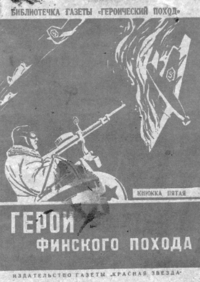Winter War in popular culture
The influence of the Winter War in popular culture has been deep and wide, both in Finnish culture and worldwide. The Winter War began three months after World War II started, and the war had full media attention as other European fronts had a calm period.
| Winter War |
|---|
| Articles |
| Related topics |
Films and television
The Soviet documentary film, The Mannerheim Line (1940), presents the official view of the Winter War between Nazi-allied Finland and the USSR, including its causes, denouement, and outcome.
The play There Shall Be No Night (1940) by American playwright Robert E. Sherwood was inspired by a moving Christmas 1939 broadcast to America by war correspondent Bill White of CBS. The play was produced on Broadway in 1940 and won the 1941 Pulitzer Prize for Drama.
The American film Ski Patrol (1940), photographed by the Hollywood master Milton Krasner,[1] features a Finnish reserve unit defending the border against Russians.[2] The film took great historical liberties in its storyline.[3]
The Finnish movie Talvisota (1989) tells the story of a Finnish platoon of reservists from Kauhava. The platoon belongs to the 23rd Infantry Regiment, which consists almost solely of men from Southern Ostrobothnia.
The documentary Fire and Ice: The Winter War of Finland and Russia (2006) shows how the Winter War influenced World War II and how Finland mobilized against the world's largest military power.
In 2011, Philip Kaufman began filming HBO's Hemingway & Gellhorn (first airdate May 28, 2012), which features Martha Gellhorn (played by Nicole Kidman) reporting from Finland during The Winter War. Steven Wiig portrays Simo Häyhä, leading a group of Finnish soldiers to shelter.
Games
In a 1992 column in Pelit, "Wexteen" (Jyrki J. J. Kasvi) lamented the difficulty of modelling the war in interactive entertainment. According to Wexteen, if the game mechanics are based on troop strengths, troops will march through Helsinki; if on historical events, through Moscow.
The Winter War was featured in a scenario of the grand strategy game Hearts of Iron 2 and received dedicated games in the wargame Squad Battles: Winter War and the educational real-time strategy game Talvisota: Icy Hell.
Several commercial "map and counter" board games have been published which cover the campaign:
- Winter War (1972), Simulations Publications
- Arctic Storm: The Russo-Finnish Winter War 1939–40 (1992), GMT Games
- A Winter War (1994), Game Research/Design (Europa Series)
- Molotov's War: Russo-Finish Conflict, 1939–40 (1995), Decision Games
- The Finnish Trilogy: Vol. 1 Winter War 1939-1940 (2014), Mikugames
Literature

At the end and within a year after the Winter War – years 1940–1941 – much literature was published in the Soviet Union. Books were very narrow by their military history and operations, but they had a strong political in-line message. The overall campaign was disastrous, so literature found its pride in the details of battles and military heroes. For example, the breakthrough of the Mannerheim Line was represented as a "legendary" performance by the Red Army.[4]
The boys' adventure story Biggles Sees It Through (1940) by W.E. Johns is set during the final stages of the war. Squadron Leader James Bigglesworth is allowed by the British government to go in a party of volunteers to "help the Finns in their struggle against Soviet aggression". They fly reconnaissance raids from a base at Oskar, in a Bristol Blenheim bomber, and encounter a Polish scientist with secret papers on new aircraft alloys, plus von Stalhein their old World War I enemy.
Phantom Patrol (1940) by Arthur Catherall (writing as AR Channel) is another boys' adventure story about a group of Boy Scouts in Finland during the Winter War, who become involved in guerilla activity for the Finnish forces.[5]
Music
Already during the war, in February 1940, Trinidadian calypso musician Atilla the Hun recorded a song called "Finland", urging Finland to help "[d]efeat the aims of Soviet Russia".[6]
The Swedish heavy metal band Sabaton made a song called "Talvisota" in their "The Art of War" album in 2008.[7]
References
- "Ennennäkemätön talvisotaelokuva Ski Patrol" [Never-before-seen Winter War film Ski Patrol] (in Finnish). Finnish Film Archive. Retrieved 2011-11-30.
- "Ski Patrol (1940)". IMDb. Retrieved 2011-11-30.
- "Ennennäkemätön talvisotaelokuva Ski Patrol" [Never-before-seen Winter War film Ski Patrol] (in Finnish). Finnish Film Archive. Retrieved 2011-11-30.
- Uitto, Antero Uitto (1999). Talvisota puna-armeijan silmin (in Finnish). p. 83.
- Channel, AR. Phantom Patrol. ASIN B000MUT2QG.
- Pekka Gronow (9 May 2007). "Talvisota Trinidadilla". Yle Blogit (in Finnish). Retrieved 26 February 2015.
- "Talvisota". Sabaton Official Website. Retrieved 2020-07-24.